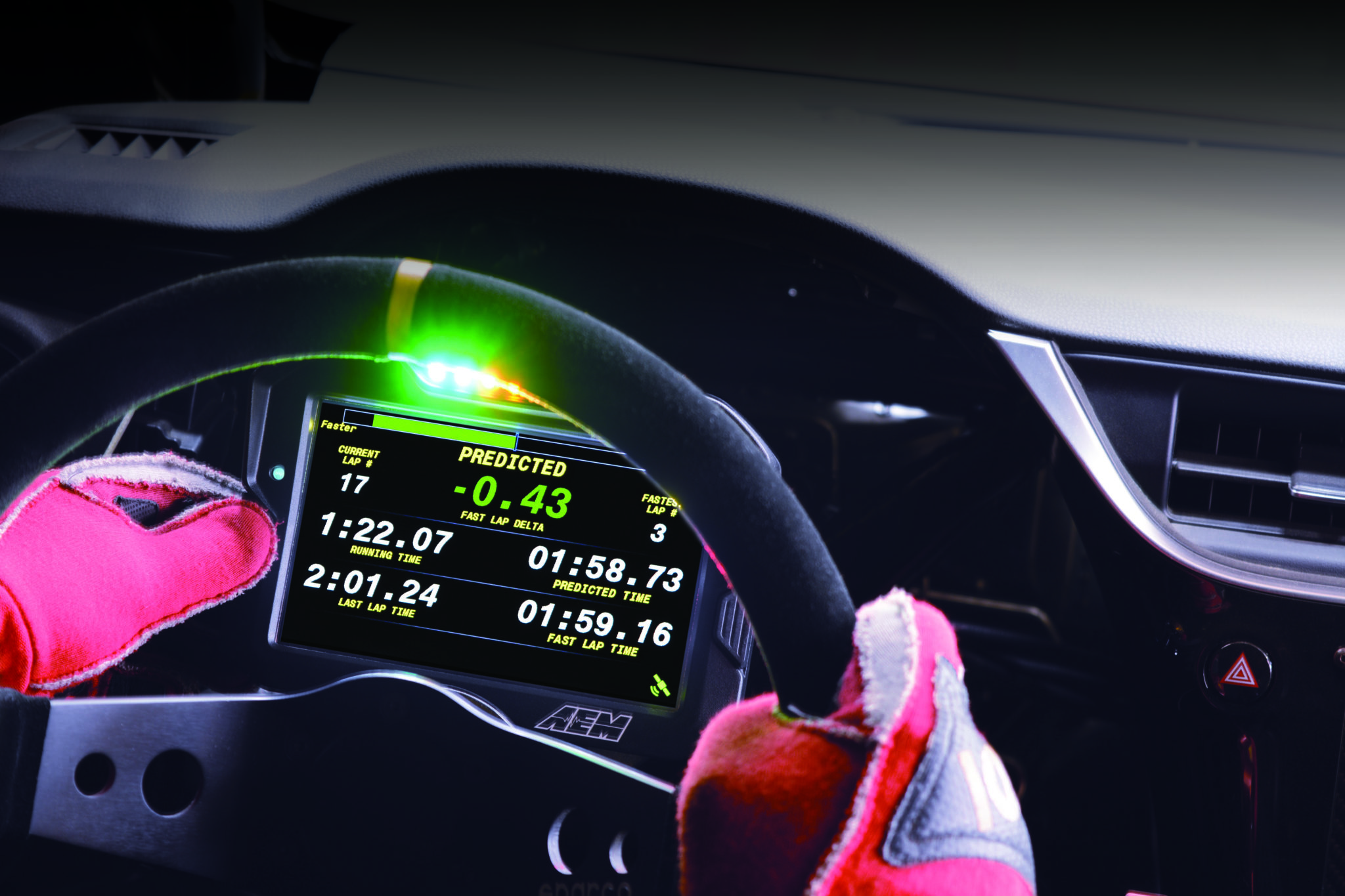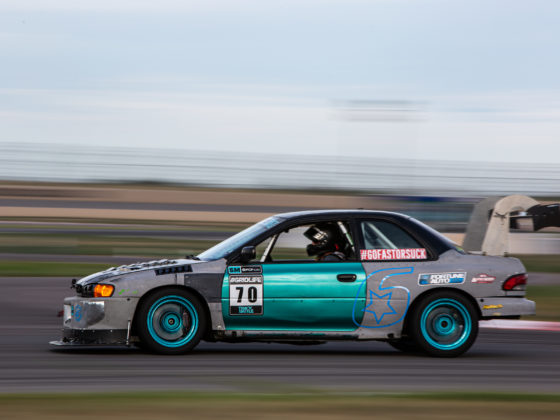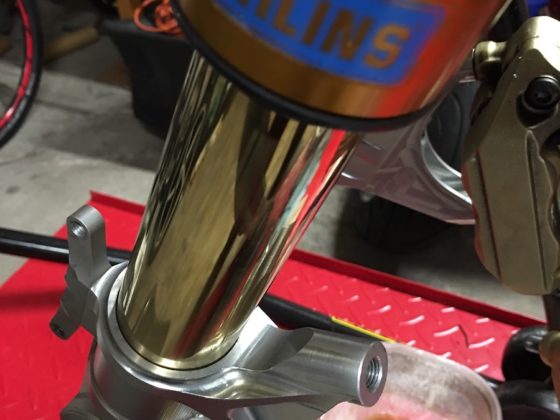If you’re a racer, a track day junkie, or just love teasing your car’s limits, you’ve probably never said: “I’m fine with not going any faster.” We’re all on a constant hunt for more speed and quicker lap times, be it through traction, horsepower, or the one factor that no one wants to admit to, the driver. A fast car can fool a mediocre driver into thinking they have chops, but a skilled driver can turn any slow car into a fast one. But where does one get started in honing their skills? The common first step lies in racing schools, lots of reading, and private coaching to get you started on the right foot. Second, comes a tool that every driver at every level should never overlook. The key to moving on from good to great lies in data, and today there are more options than ever to keep you covered.
Some of you may be asking, “but seriously, how big of a difference could data make?” The advantage that data systems bring to the table is that you can study your driving down to the hard numbers. A lap timer only tells you if a lap was slower or faster, onboard videos tend to only reveal big mistakes but not small bad habits, and a coach in the right seat is limited by trying to watch your eyes, hands, feet, and the track all at once. Data, however, puts all of the information together in a format that allows you to pick apart your driving technique and car setup in extreme detail. This way, you can learn that perhaps you’re not using the brakes to their full capacity, or you’re too slow to get on the throttle, or just that you simply aren’t carrying enough momentum in the corners. No matter what the areas of improvement are, the data will reveal it.
Before digging into how to analyze this information, the first step is selecting the right hardware to gather it. “Data” is a broad term in the Motorsports world, as it often refers to a mobile app, a complicated system of sensors and wires, and everything in between. As with most things with cars and Motorsports, accomplishing more calls for deeper pockets, but the return can be massive. Here’s a look at some of the most popular options for beginners, experienced enthusiasts, and those looking to go pro.
Mobile Apps
Just getting started? Looking for something easy and affordable? Mobile apps have gained a lot of traction with the track day and HPDE crowd, as most of them are simple to set up and require nothing beyond your cell phone. At $10-$30, it’s low risk and has the potential for big payoff with how much information it can actually provide. A major plus with this option is that your phone can double as an onboard video camera as well as a data logger in many cases. This means that you can use your videos with the data overlay to brag on social media, or to learn how to improve your driving.
Mobile apps are affordable, easy to use, and carry a surprising amount of functionality, so what’s the catch? Like with most technologies, if there’s dedicated hardware that exists to do a job, there’s a good chance that a phone app can check off most of the same boxes but not all of them. The amount of data that can be collected is limited, and the rate at which it is logged will rarely measure up to the more serious tools. Adding to that, how in-depth do you want to get when you review your lap data? Mobile apps are catching up with graphing and chart functionality, but for the most part, you’ll still end up with a bigger picture story rather than the finer details on where you can shave off fractions of a second from corner to corner.
If you’re in it just for the lap times, speed readouts, and video, you can probably call it good right here. If you’re feeling competitive and want to dial in both driver and car setup, it’s time to upgrade to the next step.

Harry’s Lap Timer sits among the more popular options if you aren’t willing to throw the money at a dedicated piece of hardware. However, don’t judge too quickly as this mobile app is constantly receiving updates and additional features. Although it’s popularly used as a lap timer and video recorder with data overlay, its functionality reaches much deeper. The app starts at $8.99 with your basic timing data, plus external GPS and OBD support. The next step up, the Petrolhead Edition, adds video recording and overlay, plus real-time online sharing for $12.99. The Laptimer Grand Prix Edition is the most expensive version available at $27.99, but it also allows for multi-camera setups, data analytics, and custom sensors for extra data.

RaceChrono has been around for a while, dating back to 2007 first for Nokia phones before making its way to Android and iOS devices. Like the competition, it readily functions as a basic lap timer, but has plenty of room to get more serious if you want it to. RaceChrono currently offers two levels of software, with the fully-featured version costing $17.99. While the basic version delivers the bare essentials of lap timing and GPS data, the Pro version offers a whole lot more. RaceChrono Pro brings with it predictive lap timing, multi-camera recording (plus picture-in-picture export), support for wireless OBD-II readers, and more.




5 comments
I’m very interested in the Fueltech FT series Dash/datalogger/ECUs, I like the idea of an all-in-one system both for the simplicity and for the ease of installation/debugging/tuning. The only thing holding me back is support, its a Brazilian company with little representation or support outside south america. If AiM offered a similar product I would buy it in a heartbeat.
The secret to being a great driver has much more to do with understanding slip angles. When you understand how tires work to produce maximum grip, then you can start improving your laptimes.
The key, is understanding what ‘being on the limit’ really means. First, you must know what the best temps are for your tire. Make sure that temp is evenly distributed across all tires, and then you must drive in a way to keep the tires at those temps without exceeding high/low limits.
After that, you must understand that tires produce maximum traction dependent on the normal force (weight+downforce), ideally you want maximum downforce, at all speeds, and to distribute weight to minimize CoG, and polar moments (of course, it depends on FWD, RWD, AWD.)
Considering all those factors together, you also need to have the courage to drive all tires at the edge of the traction circle, determined by slip angle. That’s why Anti-Ackerman works for race tires, and also very slight drift angles (the rear tires need slip angles 3-5 degrees to generate maximum cornering force.)
In summation, you need to understand all these concepts intuitively (like Senna) AND you must be willing to drive at those limits. It’s very rare that somebody can put all those elements together, but when they do, the driver’s ability becomes far greater than the sum of the parts.
Dont forget https://www.autosportlabs.com/
RACECAR DEVELOPMENT NOTES
The list below should read as a development schedule. So, it starts with the basic stuff, and gets more advanced. I do believe that you must first build a solid chassis before you start on Engine/Horsepower modifications, so that’s how the list is arranged.
Driver Essentials (Before Vehicle Modification)
Read as much as possible on driving and vehicle development before modifying your vehicle.
Develop goals/targets for vehicle depending on street, track, or full race goals.
Steering Wheel (Leather, Aftermarket Race Wheel, etc.)
Race Pedals (Optimize for heel/toe shifting.)
Driving Gloves/Shoes/Sunglasses (Improved feel and performance while driving.)
Race Seat/Race Harness (Depending on street vs. track vs. full race)
Blacked Out Dash/Felt/Flocking (To reduce glare.)
Aftermarket Instrumentation (Tachometer, Oil Pressure Gauge, Water Temp Gauge, Boost Gauge, OBD2 ELM App (DashCommand, etc.))
CHASSIS/SUSPENSION DEVELOPMENT ORDER
1. Chassis Geometry (Street Car vs. Track Car)
(Obviously, you can’t change all of these variables, so they should be considered before you purchase a particular vehicle platform.)
Track (Wide track for maximum cornering grip vs. Narrow track for lower aero drag to maximize top speed.)
Wheelbase (High speed racing (HPDE & Drag Racing) vs. Low speed racing (AutoX))
Ride Height (Necessary wheel travel dependent on road surface variation.)
Suspension Type (Optimization of MacPherson vs. Double Wishbone vs. Multilink)
2. Mass Optimization (Reduction, Relocation, CoG & Polar Moment)
Unnecessary Part Deletion, Hole Drilling, Mass Relocation (Battery, Ancillary parts)
CoG & Polar Moment Optimization (Moving mass closer to the ground plane and reducing/increasing polar moment depending on racing category. (Reduce polar moment on AutoX, Time Attack, but increase on Drift.))
Part Material Replacement (Lexan Windows, Aluminum, Titanium, Carbon, etc.)
3. Chassis Stiffness (Dependent on Tire Grip/Spring Rates)
Bushings vs. Spherical Bearings (Street vs. Track)
Strut Tower Bars (Strut bars should be light and stiff, and doubled bolted to handle bending/moment loads.)
Custom Structural Bracing (Triangulation between frame members.)
4. Spring Rates (Dependent on Street vs. Race Tire)
Spring Rates Depends on FWD, AWD, RWD
Corner Weighting (Balance Optimization)
Air Springs (Non-Linear spring rate needs specific damper tuning)
Progressive Coils or Tender Springs (Dependent on street vs. track surfaces.)
Spring Preload Optimization (Street vs. Track)
5. Dampers
Twintube vs. Monotube (Monotubes are better for low travel suspensions considering higher volume fluid displacment for given displacement.)
Fixed vs. Adjustable (Street vs. Track Car)
Electrically Controlled/Dynamic Damping (Ideal for street cars that see various road surfaces.)
6. Tires & Wheels & Alignment
Street Rubber (Grip vs. All-Weather Performance)
Race Slicks (Heat Cycling, Tire Stretch, )
Race Wheels (Forged vs. Spin Casting, Offset, Width)
Street Wheels (Lightweight vs. Durability)
Slip Angle Optimization (Sidewall Compliance vs. Ultimate Grip & Steering Response)
Tire Temperature Optimization (Possibly necessitating staggered tire sizes.)
Camber (Dependent on Suspension Type)
Toe (Toe-in for vehicle stability, Toe-out for rotation)
7. Braking System
Upgraded Pads (Street vs. Track)
Upgraded Rotors (Premium Damped Iron, Electroplated, etc.)
Brake Master Cylinder Brace
Aftermarket Stainless Steel Brake Lines
Aftermarket Calipers (Dual Caliper Sliding Piston, Fixed Caliper 4-Piston, etc.)
High Temp DOT5 Racing Brake Fluid
Aftermarket Two-Piece Floating Rotors (Slotted, Crossdrilled, Carbon, Carbon-Ceramic, etc.)
Aftermarket Race Pads (High Temp. Pads for aftermarket rotors.)
8. Aerodynamics
Stock Sheet Metal Optimization (Front first/Rear last due to boundary layer separation: Hood Vents, Plugging Unnecessary Bumper Openings, Reducing Panel Gaps, Fender Cutouts, etc.)
Front Airdam/Splitter (Street vs. Track)
Custom Wheel Strakes/Air Curtains (To reduce airflow into wheel well.)
Aftermarket Body Kit (Widebody, Aero Optimized, etc.)
Aftermarket Rear Wing
Aftermarket/Custom Front and/or Rear Diffuser
Aftermarket Vortex Generators
ENGINE/TRANSMISSION/DIFFERENTIAL DEVELOPMENT ORDER
(This list is highly dependent on NA, Turbo/SC)
1. Engine (Essential Maintenance)
Cam Belts, Water Pump, Engine Bearings, Valve Lash Adjustment, etc.
2. Oil System
Premium Synthetic Oil & Filter
Cerratech, LubroMoly Oil Additives
Oil Plug Magnet + Neodymium Magnets (On oil filter.)
Oil Canister Hose Clamps (To reduce canister wall flex under high oil pressure.)
3. Thermal Management
Coolant Flush/Replacement
Coolant Additives (Water Wetter)
4. Engine Mounts
Hard Rubber (Street), Polyurethane (Track), Aluminum (Extreme Race)
5. Exhaust System
Aftermarket /Custom Catback Exhaust (Mild Steel vs. SS vs. Ti)
Headers (4-2-1 vs. 4-1, Exhaust Wrap)
Race Pipe and/or Race Catalytic Converter
6. Intake System
Flat Panel Type vs. Cone Air Filter (Street vs. Track)
Aftermarket Intake System (Short Ram (+HP) vs. Cold Air (+TQ))
Race Pipe and/or Race Catalytic Converter
Intake Manifold Spacer (To reduce heat xfer from the head to the manifold
7. Fuel System
Fuel Pump Rewire (To maximize voltage at pump.)
Fuel Pump Upgrade (Dependent on NA or Turbo/Supercharged
Fuel Rail (Turbo/SC)
Full Fuel System Replumbing (Turbo/SC)
8. ECU Tuning
ECU Reflash/Chipped
Aftermarket ECU (Necessitating Engine Dyno testing)
9. Transmission / Differential (HP Dependent)
Upgraded Shifter (Poly/Bronze Bushings, Short Shift vs. Long Shift (Street vs. Track))
Synthetic Transmission/Differential Fluid
Aftermarket Clutch (Street vs. Track, HP Dependent)
Aftermarket Flywheel (Street vs. Track)
Transmission/Differential Cooler
10. Engine Internals
Aftermarket Oil Pump / Oil Pan
Windage Tray / Improved Oil Scavenging / Full Race Dry Sump
Aftermarket Rod Bolts/Rods
Aftermarket Pistons/Pin/Rings
Aftermarket Camshafts/Springs/Retainers
Aftermarket Valves/Valve Guides
Race Porting/Polishing
Engine Blueprinting/Deburring/Balancing
Aftermarket Engine Sleeves/Crankshaft
11. Transmission/Driveline (Advanced Modifications)
Optimized Gearing (High Speed vs. Torque)
Aftermarket Differential (Viscous, Clutch, Torsen)
Aftermarket Driveshaft (Aluminum, Carbon)
Race Type Transmission (Sequential Shift, etc.)
I can’t seem to find the data analysis article, maybe I’m not looking in the right place though.